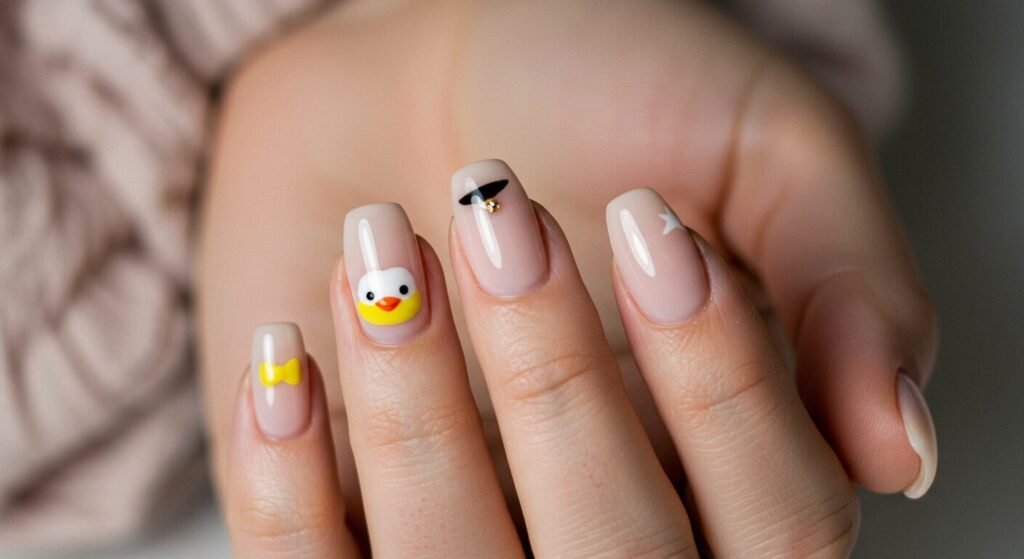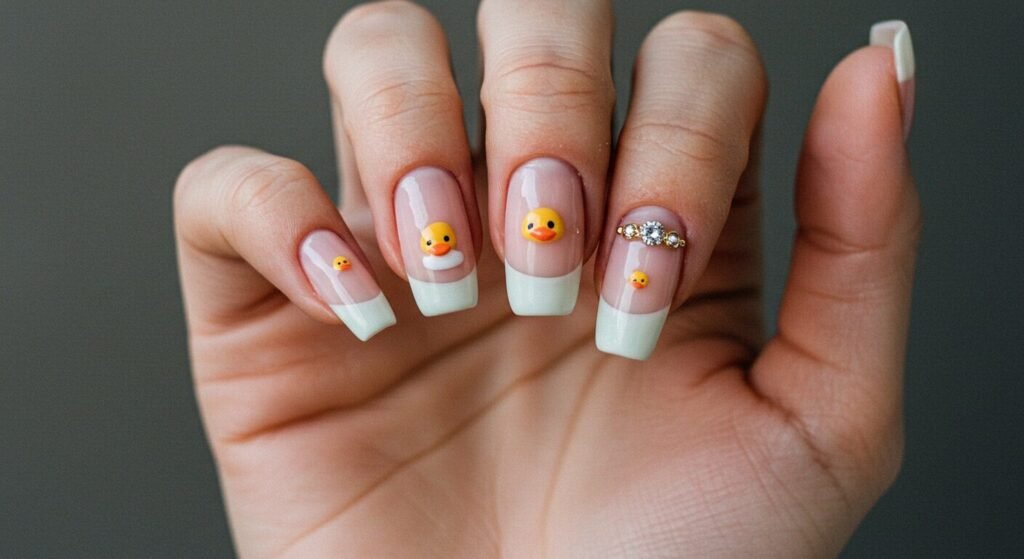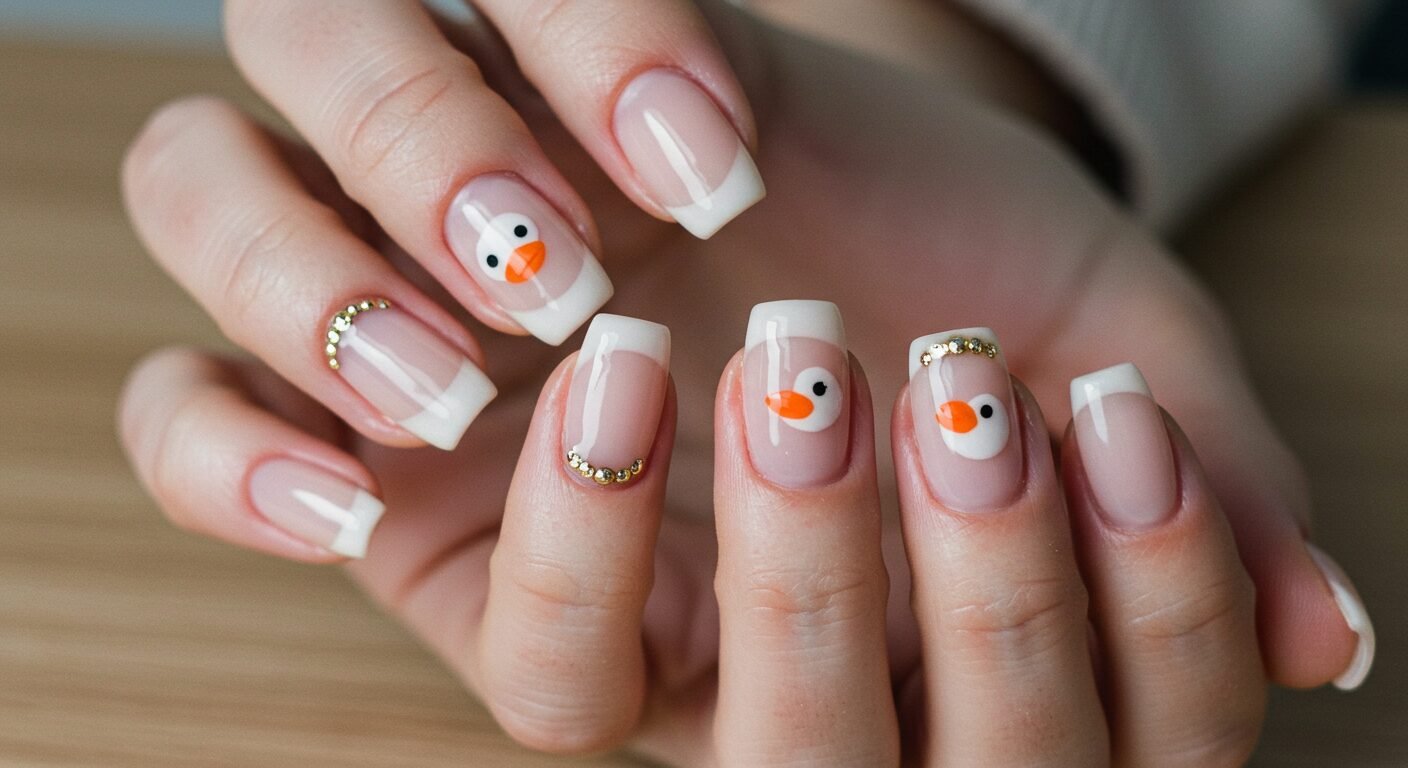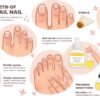Are you tired of the same old nail shapes and ready to try something that’ll make your manicure stand out from the crowd? Duck shape nails might just be the bold, edgy look you’ve been searching for. This unique nail shape has been gaining massive popularity across social media platforms, with nail enthusiasts and celebrities alike embracing its distinctive silhouette.
But what exactly are duck shape nails, and why are they causing such a buzz in the beauty world? Whether you’re a nail art newbie or a seasoned pro, this comprehensive guide will walk you through everything you need to know about duck nails, from their origin story to maintenance tips that’ll keep your manicure looking flawless.
What Are Duck Shape Nails?
Duck shape nails, also known as “flare nails” or “fan nails,” get their name from their resemblance to a duck’s webbed foot. These nails feature a unique silhouette where the nail tip flares out dramatically, creating a wide, fan-like appearance that’s both striking and controversial.
The shape is characterized by its narrow nail bed that gradually widens toward the free edge, creating an almost triangular or fan-like appearance. Think of it as the opposite of a coffin or stiletto nail – instead of tapering to a point, duck nails spread outward like fingers of a hand or, you guessed it, a duck’s foot.
This unconventional shape challenges traditional nail aesthetics and has become a statement piece for those who want their manicure to be a conversation starter. The wider tip provides an excellent canvas for intricate nail art designs, making it a favorite among creative nail artists and their clients.
The History and Origin of Duck Shape Nails
Duck shape nails didn’t emerge overnight – they’re actually rooted in decades of nail evolution and cultural expression. The shape first gained attention in urban communities and among nail artists who were pushing the boundaries of traditional manicure styles.
The trend can be traced back to the early 2000s when nail technicians began experimenting with more dramatic shapes and lengths. However, duck nails truly exploded into mainstream consciousness through social media platforms like Instagram and TikTok, where nail artists showcased increasingly creative and bold designs.
Celebrities and influencers played a crucial role in popularizing this shape. When high-profile figures started sporting duck nails at red carpet events and in their social media posts, the trend gained legitimacy and widespread appeal. The shape represents a rebellion against conventional beauty standards and embraces individuality and self-expression.
Duck Nails vs. Other Popular Nail Shapes

Understanding how duck nails compare to other popular shapes helps you appreciate their unique characteristics and decide if they’re right for you.
Duck Nails vs. Coffin Nails: While coffin nails taper inward toward the tip, duck nails do the opposite – they flare outward. Coffin nails offer elegance and sophistication, while duck nails make a bold, edgy statement.
Duck Nails vs. Stiletto Nails: Stiletto nails come to a sharp point, making them impractical for daily activities. Duck nails, despite their width, can be more functional since they don’t have pointed tips that easily break or snag.
Duck Nails vs. Square Nails: Traditional square nails maintain the same width from base to tip. Duck nails start narrow and expand dramatically, creating visual interest and a unique silhouette that square nails simply can’t achieve.
The key difference lies in the drama factor – duck nails are designed to be noticed and make a statement, while traditional shapes often prioritize practicality and subtle elegance.
How to Achieve the Perfect Duck Shape
Creating the perfect duck nail shape requires skill, patience, and the right techniques. Whether you’re visiting a professional or attempting this at home, understanding the process is crucial for achieving the desired look.
The foundation starts with having adequate nail length – duck nails simply can’t be achieved on short nails. You’ll need either long natural nails or extensions using gel, acrylic, or dip powder systems. Most nail technicians recommend starting with extensions to achieve the dramatic width that defines this shape.
The shaping process involves careful filing and sculpting. The nail artist starts by creating the basic elongated shape, then begins the gradual flaring process. This requires specific filing techniques, moving from the center of the nail outward to create that characteristic fan shape.
Professional nail technicians use a combination of different grits of files and buffers to achieve the smooth, even curve that makes duck nails so distinctive. The process can take significantly longer than traditional nail shapes due to the precision required.
Professional vs. DIY Duck Nails
Deciding between professional application and DIY duck nails depends on your skill level, budget, and desired outcome. Each approach has distinct advantages and challenges that you should consider carefully.
Professional Application Benefits: Experienced nail technicians have the expertise to create perfectly symmetrical duck nails that look polished and professional. They have access to high-quality products and tools that ensure durability and longevity. Professional application also typically includes proper nail preparation and aftercare advice.
DIY Approach Considerations: While more budget-friendly, creating duck nails at home requires significant skill and patience. You’ll need to invest in quality files, buffers, and extension materials. The learning curve can be steep, and achieving symmetry between all ten nails can be challenging for beginners.
Many people choose to have their first set done professionally to understand the shape and technique, then attempt maintenance and future sets at home. This hybrid approach allows you to learn while ensuring your first experience with duck nails is successful.
Essential Tools and Products for Duck Nails
Creating stunning duck nails requires specific tools and high-quality products. Having the right equipment makes the difference between amateur-looking nails and a professional finish that’ll turn heads wherever you go.
Filing Tools: You’ll need multiple nail files with different grits – coarse files for initial shaping, medium files for refining the curve, and fine files for smoothing. A curved file specifically designed for nail art can be particularly helpful for achieving the perfect duck shape.
Extension Materials: Whether you choose acrylic, gel, or dip powder, quality extension materials are crucial. Each has its own benefits – acrylic offers strength and durability, gel provides a more natural feel, and dip powder combines the best of both worlds.
Nail Art Supplies: Duck nails provide an excellent canvas for creative designs. Stock up on nail polishes, gel colors, nail art brushes, dotting tools, and decorative elements like rhinestones, glitter, and foils to maximize your creative potential.
Don’t forget the basics – nail dehydrator, primer, base coat, top coat, and cuticle oil are essential for proper nail preparation and maintenance.
Step-by-Step Guide to Creating Duck Nails

Ready to try duck nails yourself? This detailed guide will walk you through each step of the process, ensuring you achieve the best possible results.
Preparation Phase: Start by removing any existing polish and pushing back your cuticles. Clean your nails thoroughly with rubbing alcohol to remove oils and debris. Apply nail dehydrator and primer to ensure proper adhesion of your chosen extension material.
Extension Application: Apply your chosen extension material (acrylic, gel, or dip powder) according to the manufacturer’s instructions. Build up length gradually, creating a strong foundation for the shaping process. Allow proper curing time between layers.
Initial Shaping: Begin with a coarse file to create the basic elongated shape. Work slowly and check your progress frequently to ensure even length across all nails.
Creating the Flare: This is the most critical step. Starting from the center of each nail, file outward to create the characteristic fan shape. Work in small sections and frequently check that both sides are developing symmetrically.
Refining and Smoothing: Use progressively finer files to smooth the edges and perfect the curve. The final result should have smooth, even lines with no rough spots or asymmetry.
Popular Duck Nail Designs and Art Ideas
The wide tip of duck nails creates an incredible canvas for artistic expression. From subtle elegance to bold statements, there’s a duck nail design for every personality and occasion.
Ombre Effects: The gradual width increase of duck nails makes them perfect for ombre designs. Try classic color gradients, or experiment with glitter ombres that catch the light beautifully. The shape naturally enhances the flowing effect of ombre techniques.
Geometric Patterns: The unique shape lends itself perfectly to geometric designs. Triangle patterns, chevron designs, and abstract shapes all work beautifully on duck nails. The wide tip provides space for intricate geometric art that would be impossible on narrower nail shapes.
Floral Designs: Delicate flowers look stunning on duck nails, with the wide tip providing space for detailed petals and leaves. Cherry blossoms, roses, and abstract floral patterns all complement the organic, flowing shape of duck nails.
Metallic and Chrome Finishes: The reflective surface of metallic polishes looks particularly striking on duck nails. The shape creates interesting light reflections that enhance the metallic effect, making your nails appear almost liquid-like.
Maintenance and Care Tips
Maintaining duck nails requires dedication and proper care techniques. Their unique shape presents specific challenges that traditional nail shapes don’t face, making proper maintenance crucial for longevity.
Daily Care Routine: Moisturize your cuticles daily with quality cuticle oil to prevent dryness and hangnails. The extended length of duck nails puts additional stress on your natural nail bed, making hydration essential for nail health.
Activity Modifications: Duck nails require lifestyle adjustments. Simple tasks like typing, opening cans, or buttoning clothes can become challenging. Developing new techniques for daily activities is part of the duck nail experience.
Regular Maintenance Appointments: Plan for more frequent salon visits compared to traditional nail shapes. Duck nails typically need maintenance every 2-3 weeks to maintain their shape and prevent lifting or cracking.
Protection Strategies: Wear gloves during cleaning or gardening activities. The wide tips of duck nails are more susceptible to snagging and breaking, so protection during potentially damaging activities is essential.
Pros and Cons of Duck Shape Nails
Like any beauty trend, duck nails come with both advantages and disadvantages. Understanding both sides helps you make an informed decision about whether this dramatic nail shape fits your lifestyle and preferences.
Advantages of Duck Nails: The most obvious benefit is their unique, eye-catching appearance that guarantees attention and compliments. The wide tips provide an excellent canvas for elaborate nail art designs that simply aren’t possible on other shapes. Duck nails also allow for incredible creative expression and individuality.
Practical Considerations: The dramatic shape can interfere with daily activities like typing, cooking, or using your phone. The wide tips are more prone to snagging on clothing, hair, and other objects. Maintenance costs can be higher due to more frequent salon visits and the skill required for proper shaping.
Social Aspects: While duck nails make a bold fashion statement, they might not be appropriate for all work environments or social situations. Consider your lifestyle and professional requirements before committing to this dramatic nail shape.
Cost Considerations and Budgeting
Understanding the financial commitment of duck nails helps you budget appropriately and avoid unexpected expenses. The unique shape and maintenance requirements make duck nails a more significant investment than traditional manicures.
Initial Application Costs: Professional duck nail application typically costs more than standard shapes due to the time and skill required. Expect to pay premium prices for this specialized service, especially from experienced nail artists who specialize in dramatic shapes.
Ongoing Maintenance Expenses: Regular maintenance appointments every 2-3 weeks add up quickly. Factor in the cost of repairs if nails break or chip, which can happen more frequently with this dramatic shape.
DIY Cost Analysis: While DIY application saves money on labor costs, you’ll need to invest in quality tools and materials. Calculate the cost of files, extension materials, polishes, and art supplies to determine if DIY is truly more economical.
Long-term Investment: Consider duck nails as a beauty investment rather than a one-time expense. Quality application and proper maintenance protect your investment and ensure you get the most value from your dramatic new look.
Common Mistakes and How to Avoid Them
Learning from common duck nail mistakes helps you achieve better results and avoid frustrating setbacks. These pitfalls are easily avoidable with proper knowledge and preparation.
Shape Inconsistency: One of the most common mistakes is creating uneven shapes across different nails. Take time to measure and compare your nails throughout the shaping process. Use templates or guides if necessary to ensure consistency.
Filing Too Aggressively: Rushing the shaping process often leads to over-filing and weakened nails. Work slowly and patiently, checking your progress frequently. Remember that you can always remove more material, but you can’t add it back easily.
Inadequate Preparation: Skipping proper nail preparation leads to lifting, chipping, and premature failure. Always properly clean, dehydrate, and prime your nails before applying extensions or polish.
Ignoring Nail Health: Getting caught up in the dramatic appearance while neglecting nail health leads to damage and breakage. Maintain regular cuticle care and give your natural nails breaks between applications when possible.
Duck Nails and Lifestyle Compatibility
Before committing to duck nails, honestly assess how they’ll fit into your daily life. This dramatic nail shape requires significant lifestyle adjustments that not everyone is prepared to make.
Professional Considerations: Many workplaces have grooming policies that might not accommodate extreme nail shapes. Healthcare workers, food service employees, and those in conservative business environments should carefully consider workplace appropriateness.
Daily Activity Impact: Simple tasks become more complex with duck nails. Texting requires learning new techniques, opening packages becomes challenging, and contact lens wearers may find insertion and removal more difficult.
Sports and Exercise: Most physical activities are incompatible with duck nails. Swimming, rock climbing, tennis, and even yoga can become problematic with long, wide nails that easily snag or break.
Personal Comfort Level: Some people love the attention that dramatic nails bring, while others find it overwhelming. Consider your personality and comfort level with being the center of attention before choosing this bold nail shape.
Seasonal Trends and Duck Nail Variations
Duck nails adapt beautifully to seasonal trends and offer numerous variations to keep your look fresh and current throughout the year.
Spring and Summer Variations: Bright, vibrant colors work beautifully on duck nails during warmer months. Tropical themes, fruit designs, and ocean-inspired art complement the season perfectly. Consider shorter versions for summer activities while maintaining the characteristic flare.
Fall and Winter Adaptations: Darker colors, metallic finishes, and holiday-themed designs make duck nails perfect for cooler months. Deep burgundies, forest greens, and glittery gold create stunning seasonal looks that capture the essence of autumn and winter.
Special Occasion Styles: Wedding duck nails with delicate lace patterns, graduation nails with school colors, or holiday nails with themed decorations show how versatile this shape can be for special events.
Cultural and Trend Integration: Duck nails easily incorporate current beauty trends, from minimalist designs to maximalist art. Stay current by adapting popular color palettes and design elements to your duck nail canvas.
Celebrity Influence and Social Media Impact
The rise of duck nails can’t be separated from celebrity influence and social media trends. Understanding this connection helps explain the shape’s popularity and evolution.
Celebrity Pioneers: Several high-profile celebrities and influencers helped bring duck nails into mainstream consciousness. Their red carpet appearances and social media posts sparked widespread interest and legitimized the trend among fashion-forward individuals.
Social Media Amplification: Instagram and TikTok nail artists have created viral content featuring duck nails, with some videos garnering millions of views. These platforms allow nail artists to showcase their creativity and inspire others to try the trend.
Influencer Impact: Beauty influencers and nail artists with large followings have significant impact on nail trends. Their tutorials, reviews, and styling tips help newcomers navigate the duck nail experience successfully.
Cultural Significance: Duck nails represent more than just a beauty trend – they symbolize self-expression, creativity, and the willingness to challenge conventional beauty standards. This cultural aspect contributes to their continued popularity and evolution.
Safety and Health Considerations
While duck nails are generally safe when properly applied and maintained, there are important health considerations to keep in mind for long-term nail health.
Nail Bed Health: The extended length and weight of duck nails put additional stress on your natural nail beds. Monitor for signs of damage, thinning, or weakness in your natural nails and give them breaks when needed.
Infection Prevention: Longer nails can harbor bacteria and fungi if not properly maintained. Keep your nails clean, dry, and properly groomed to prevent infections that could lead to serious health issues.
Chemical Exposure: Regular use of nail products exposes you to various chemicals. Use high-quality, safe products and ensure proper ventilation during application. Consider taking breaks between applications to minimize chemical exposure.
Physical Safety: The length and shape of duck nails can pose physical safety risks in certain situations. Be mindful of your surroundings and adjust your movements to prevent injury to yourself and others.
Future of Duck Nails and Emerging Trends
The nail industry constantly evolves, and duck nails continue to adapt and transform with new techniques, materials, and cultural influences.
Technical Innovations: New nail products and tools make duck nails more accessible and durable. Improved extension materials, better filing techniques, and innovative art supplies continue to enhance the duck nail experience.
Shape Evolution: While maintaining their characteristic flare, duck nails are evolving with subtle variations in proportions, curves, and styling. These refinements help the trend stay fresh and relevant.
Integration with Technology: Smart nail art using color-changing materials, LED elements, and other technological innovations may soon make duck nails even more dramatic and attention-grabbing.
Cultural Adaptation: As duck nails gain global acceptance, different cultures are adapting the trend to reflect local aesthetic preferences and cultural values, creating exciting international variations.
Conclusion
Duck shape nails represent more than just a beauty trend – they’re a bold statement of individuality and creative expression that challenges traditional nail aesthetics. Whether you’re drawn to their dramatic appearance, their excellent canvas for nail art, or their ability to spark conversation, duck nails offer a unique way to express your personality through your manicure.
While they require significant maintenance, lifestyle adjustments, and financial investment, many enthusiasts find the striking appearance and creative possibilities well worth the commitment. The key to success with duck nails lies in proper preparation, realistic expectations, and finding skilled professionals who can execute this specialized shape correctly.
As with any dramatic beauty choice, duck nails aren’t for everyone. Consider your lifestyle, professional requirements, and personal comfort level before taking the plunge. However, if you’re ready to make a bold statement and embrace a truly unique nail shape, duck nails might just be the perfect way to express your fearless sense of style.
Remember that nail trends come and go, but the confidence that comes from expressing your authentic self through your appearance is timeless. Whether duck nails become your signature look or just a fun experiment, they offer an opportunity to push boundaries and explore new aspects of beauty and self-expression.
FAQS
What exactly makes duck nails different from other nail shapes?
Duck nails are characterized by their unique flaring shape that widens dramatically toward the tip, resembling a duck’s webbed foot. Unlike traditional shapes that maintain consistent width or taper to points, duck nails start narrow at the base and expand outward, creating a fan-like appearance that’s both striking and unconventional.
How long do duck nails typically last before needing maintenance?
Duck nails generally require maintenance every 2-3 weeks, which is more frequent than traditional nail shapes. The dramatic shape and extended length make them more susceptible to lifting, chipping, and general wear. Regular maintenance appointments help preserve their distinctive appearance and prevent damage to your natural nails.
Can I achieve duck nails on my natural nails, or do I need extensions?
While it’s theoretically possible to create a subtle duck shape on very long natural nails, most people need extensions to achieve the dramatic flare that defines true duck nails. Extensions using acrylic, gel, or dip powder provide the necessary length and structure to create the characteristic wide, fan-like tip.
Are duck nails appropriate for professional work environments?
Duck nails may not be suitable for all professional environments, particularly conservative business settings, healthcare, food service, or jobs requiring manual dexterity. Many workplaces have grooming policies that might restrict extreme nail shapes. Consider your specific workplace culture and requirements before choosing this dramatic nail style.
What’s the average cost difference between duck nails and traditional manicures?
Duck nails typically cost 30-50% more than traditional manicures due to the specialized skill, time, and materials required. Initial application can range from $80-150 or more, depending on your location and the nail artist’s expertise. Ongoing maintenance costs are also higher due to more frequent appointments and the complexity of maintaining the shape.
READ ALSO: How Do I Get Rid of Fungal Nail? 2025 Complete Guide to Effective Treatment and Prevention
Was this helpful?
Your feedback helps us create better content
Thank you for your feedback!
Your input helps us improve our content.




